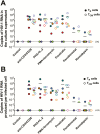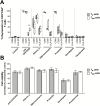Naive CD4+ T Cells Harbor a Large Inducible Reservoir of Latent, Replication-competent Human Immunodeficiency Virus Type 1
- PMID: 30753360
- PMCID: PMC6853701
- DOI: 10.1093/cid/ciz108
Naive CD4+ T Cells Harbor a Large Inducible Reservoir of Latent, Replication-competent Human Immunodeficiency Virus Type 1
Abstract
Background: The latent human immunodeficiency virus type 1 (HIV-1) reservoir represents a major barrier to a cure. Based on the levels of HIV-1 DNA in naive (TN) vs resting memory CD4+ T cells, it is widely hypothesized that this reservoir resides primarily within memory cells. Here, we compared virus production from TN and central memory (TCM) CD4+ T cells isolated from HIV-1-infected individuals on suppressive therapy.
Methods: CD4+ TN and TCM cells were purified from the blood of 7 HIV-1-infected individuals. We quantified total HIV-1 DNA in the CD4+ TN and TCM cells. Extracellular virion-associated HIV-1 RNA or viral outgrowth assays were used to assess latency reversal following treatment with anti-CD3/CD28 monoclonal antibodies (mAbs), phytohaemagglutinin/interleukin-2, phorbol 12-myristate 13-acetate/ionomycin, prostratin, panobinostat, or romidepsin.
Results: HIV-1 DNA was significantly higher in TCM compared to TN cells (2179 vs 684 copies/106 cells, respectively). Following exposure to anti-CD3/CD28 mAbs, virion-associated HIV-1 RNA levels were similar between TCM and TN cells (15 135 vs 18 290 copies/mL, respectively). In 4/7 donors, virus production was higher for TN cells independent of the latency reversing agent used. Replication-competent virus was recovered from both TN and TCM cells.
Conclusions: Although the frequency of HIV-1 infection is lower in TN compared to TCM cells, as much virus is produced from the TN population after latency reversal. This finding suggests that quantifying HIV-1 DNA alone may not predict the size of the inducible latent reservoir and that TN cells may be an important reservoir of latent HIV-1.
Keywords: HIV-1; latent; memory; naive; reservoir.
© The Author(s) 2019. Published by Oxford University Press for the Infectious Diseases Society of America. All rights reserved. For permissions, e-mail: journals.permissions@oup.com.
Figures




Comment in
-
Genetic Evidence That Naive T Cells Can Contribute Significantly to the Human Immunodeficiency Virus Intact Reservoir: Time to Re-evaluate Their Role.Clin Infect Dis. 2019 Nov 27;69(12):2236-2237. doi: 10.1093/cid/ciz378. Clin Infect Dis. 2019. PMID: 31063189 Free PMC article. No abstract available.
References
-
- Finzi D, Hermankova M, Pierson T, et al. . Identification of a reservoir for HIV-1 in patients on highly active antiretroviral therapy. Science 1997; 278:1295–300. - PubMed
-
- Wong JK, Hezareh M, Günthard HF, et al. . Recovery of replication-competent HIV despite prolonged suppression of plasma viremia. Science 1997; 278:1291–5. - PubMed
-
- Finzi D, Blankson J, Siliciano JD, et al. . Latent infection of CD4+ T cells provides a mechanism for lifelong persistence of HIV-1, even in patients on effective combination therapy. Nat Med 1999; 5:512–7. - PubMed
-
- Siliciano JD, Kajdas J, Finzi D, et al. . Long-term follow-up studies confirm the stability of the latent reservoir for HIV-1 in resting CD4+ T cells. Nat Med 2003; 9:727–8. - PubMed
Publication types
MeSH terms
Substances
Grants and funding
LinkOut - more resources
Full Text Sources
Research Materials

